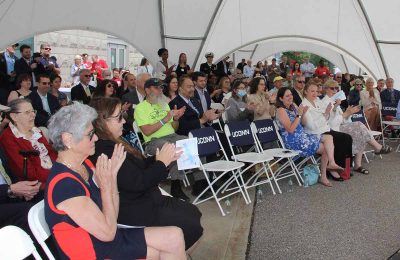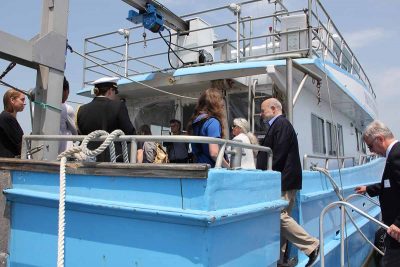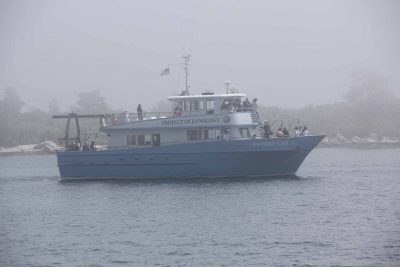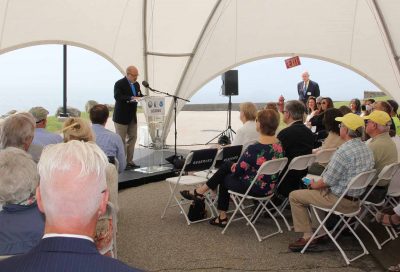
Story and photos by Judy Benson
Tidal marshes, sea grass meadows, barrier beaches and coastal forests are just some of the habitats in the federally designated reserve of Southeastern Connecticut lands and waterways that will open a wealth of opportunities for public access, hands-on environmental education, research and stewardship.
That sentiment underscored the remarks of federal, state, local and UConn officials at the May 21 ceremony celebrating the approval of Connecticut’s application to join 50,000 acres of land and underwater properties in and around the lower Connecticut and Thames rivers into the National Estuarine Research Reserve system. The lengthy process to prepare and submit the application in 2021 was led by the state Department of Energy and Environmental Protection, UConn’s Marine Sciences Department and Connecticut Sea Grant, with numerous community partners.
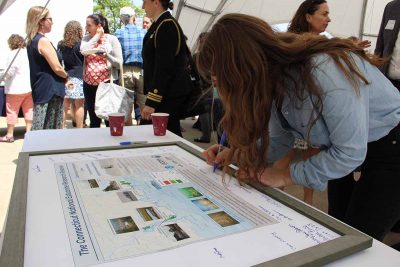
“Where saltwater meets fresh—that’s where the magic happens,” Sara Gonzalez-Rothi, senior director for water at the White House Council for Environmental Quality said at the event at the waterfront of UConn’s Avery Point campus, which will serve as the headquarters of the reserve. “Letting kids get wet” in hands-on science and exploration in the reserve, she said, will help combat “the access crisis” as the reserve also serves to face the climate crisis and the extinction crisis through research and conservation. It also aligns with the Biden-Harris administration’s goal of preserving 30% of lands and waters by 2030, she added.
“So, here’s to the piping plovers, here’s to the sturgeon, and here’s to the saltmarsh sparrow,” she said, referring to some of the endangered and threatened species found in the reserve, as the audience of about 75 people applauded.
The Connecticut Estuarine Research Reserve is the 30th to join the National Estuarine Research Reserve system, created by the National Oceanic and Atmospheric Administration. It is comprised of two state parks, Bluff Point and Haley Farm in Groton; the Lord Cove and Roger Tory Peterson Natural Area preserves and the Connecticut DEEP headquarters in the lower Connecticut River; the lower Thames River; Pine Island just offshore from Avery Point and submerged areas of Long Island Sound and Fishers Island Sound.
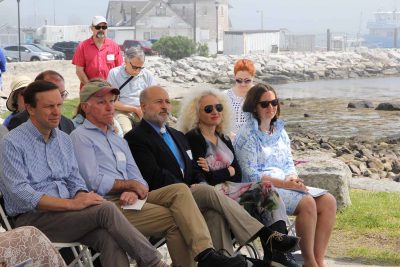
NOAA Administrator Richard Spinrad noted that the designation of the Connecticut reserve comes on the 50th anniversary of the Coastal Zone Management Act that established the reserve system. The NERRs are a critical part of NOAA’s goals to enhance resilience and public understanding to meet the challenges of sea level rise and a changing climate, he said.
“One of our highest priorities is to build a climate-ready nation by 2030, for prosperity, health, conservation and preservation, while also addressing inequities to provide access,” he said.
Sen. Chris Murphy emphasized a similar point.
“These coastal wetlands and estuaries provide us with $20 billion worth of protection” from storms and flooding, he said. The educational mission of the reserve, he added, will help remedy some past “bad decisions” that limited public access to Long Island Sound.
Rep. Joe Courtney of Connecticut’s 2nd Congressional District also spoke, while Sen. Richard Blumenthal sent remarks that read at the ceremony.
Kevin O’Brien, supervising environmental analyst who led the project for DEEP, said a Connecticut NERR was first proposed 30 years ago. But it took 20 years before the project was officially launched, and another four years before the first meeting happened in 2016.
Connecticut Sea Grant Director Sylvain De Guise said the reserve will strengthen programs already in existence in the region.
“The NERR is a nice addition that will complement the existing Coastal Management Zone and Sea Grant coastal programs in Connecticut, offering additional opportunities for synergy for the benefit of researchers, students of all ages, and the population of the state in general,” he said.
After the ceremony, guests boarded two Project Oceanology’s educational excursion vessels for 45-minute tours of a portion of the reserve. While heavy fog limited visibility, the vessels motored into the mouth of the Thames River, then around Pine Island and Bluff Point.
UConn Marine Sciences Professor George McManus, the interim manager of the reserve, said the reserve will be adding staffing over the summer and hopes to start offering programming in the fall such as kayak tours from DEEP Marine Headquarters in Old Lyme. Marine Sciences Professor Jamie Vaudrey, who led the CT NERR application process for UConn, will be the reserve’s research coordinator, he said.
“We want to carve out our own niche for education,” he said.
More information:
https://portal.ct.gov/DEEP/Coastal-Resources/NERR/NERR-Home-Page
Judy Benson is the communications coordinator of Connecticut Sea Grant.
